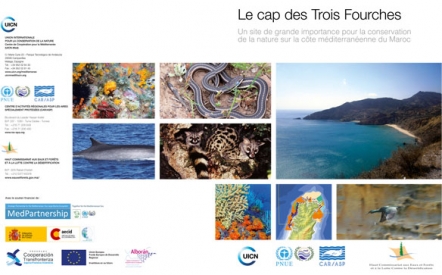Search
05-15: Discover the biological richness of ”Cap des Trois Fourches” in Morocco
The Regional Activity Centre for Specially Protected Areas (RAC/SPA) and the IUCN Centre for Mediterranean Cooperation, in collaboration with the Moroccan HCEFLCD (Haut-Commissariat aux Eaux et Forêts et à la Lutte Contre la Désertification), has just released a new publication dealing with the "Cap des Trois Fourches" on the Mediterranean coasts of Morocco.
This leaflet gathers all the available information on the biological and ecological values of both marine and terrestrial parts along with the socio-economic and cultural values of the Cap des Trois Fourches area. It would also serve as a communication tool that would improve the awareness of local stakeholders (managers, local elected representatives, civil society...) on the Marine and Coastal Protected Areas (MCPA) values.
In order to set up a national coherent protected areas' system in Morocco, and in particular to fulfill the obligations towards the Convention on Biological Diversity, the HCEFLCD tries to establish an MCPAs network, in collaboration with the Ministry of Agriculture and Maritime Fisheries (Maritime Fisheries department). Among the identified areas for the conservation of the biological diversity in Moroccan Mediterranean, the ecological and biological site of interest "Cap des Trois Fourches" appears on the priority list to be declared as future MPA.
The Cap des Trois Fourches Site includes both land and sea areas. Its marine area includes coastal areas of high biological productivity where the diversity of marine habitats (seagrass meadows, detrital or coralligenous among others) benefits local fisheries as nursery or feeding area. It is also a passage area for marine mammals, in particular the bottlenose dolphin (Tursiops truncatus). At the terrestrial part, the flora is exceptional for Morocco with a significant presence of rare species of several medicinal plants and plants of economic interest. Furthermore, its geographical location allows it to play an important role for bird migration.
This publication was co-financed within the MedMPAnet project implemented in the framework of the UNEP/MAP-GEF Strategic Partnership for the Mediterranean Large Marine Ecosystem (MedPartnership) and the POCTEFEX-Alboran project
For further information, please contact: Atef Limam (RAC/SPA) or Alain Jeudy (UICN).




Find Us On...